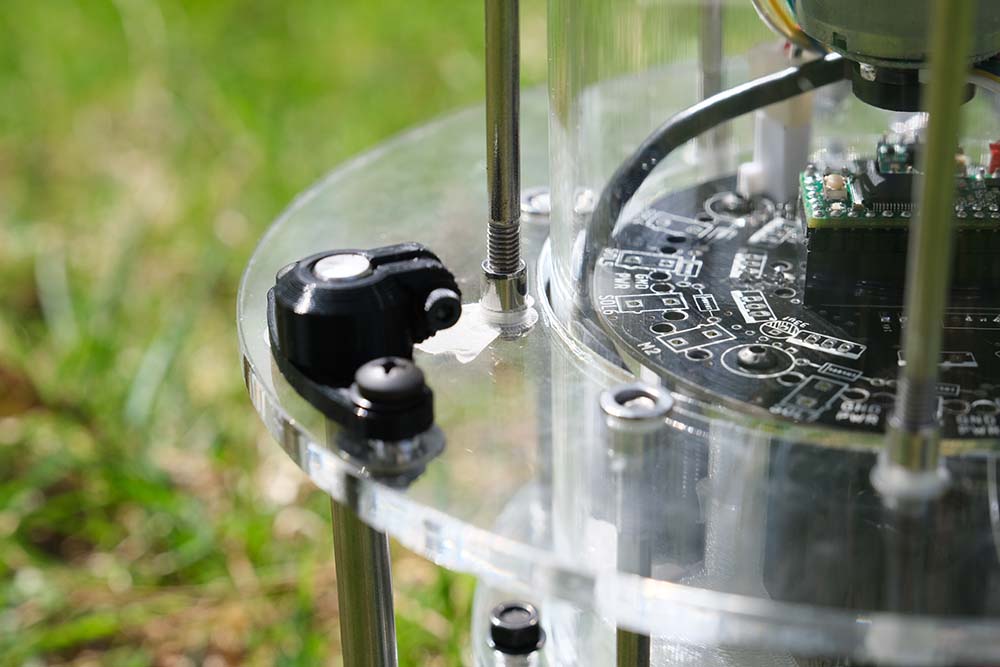Explorator spinner
The Fourth Explorator Species
While optimising existing hardware, firmware, and visual aesthetics, the fourth Explorator Hyper-Soundwalk Series installation scenario provides artefact vocalisations that complement the existing Explorator species’s biophonetic- and anthrophoneticinspired vocalisations. In this paradigm, artefact vocalisations are inspired by geophonetic sonic events as observed within some discussed related works such as: water-drips in Trimpin’s Hydraulis and Jim Finer’s Score for a Hole in the Ground; the thunder-generating lighting rods in Walter De Maria’s Lightning Field; Bruce Nauman’s microphone placed a mile into the earth crust in Untitled Piece. Within these constraints, Explorator spinner (common name Spinner) was created as the fourth Explorator species. Spinner’s name originates from the sustained vocalisations it creates through a cylindrical washboard spinning mechanism. When spun by a DC motor, vocalisations can be compared to broad-spectrum geophonetic sounds such as a waterfall or wind gusting through a forest. Spinner’s body and enclosure refines the successes of Clapper’s compact design while taking advantage of the species’ extended design schedule to produce a refined and aesthetically pleasing artefact whose 200 mm circular diameter, 273 mm height, and 2280 g weight are comparable to Clapper despite the artefact’s significantly larger vocalisation mechanism.

Cabasa Spinning Mechanism
To realise the artistic objectives of its Hyper-Soundwalk Series installation scenario,
Spinner’s vocalisation mechanism must produce geophony-inspired vocalisations
that can be sustained for extended periods. As DC motors are better equipped
than solenoids to provide sustained sounds, a DC motor is leveraged for Spinner’s
vocalisation mechanism. While there are numerous options for augmenting the rotary
movement provided by DC motors to create geophonetic vocalisations, Spinner uses
a washboard spinning mechanism constructed from a type of concussion idiophone
called a Cabasa. The mechanism consists of several beaded chains that wrap around
a perforated metal cylinder. When the mechanism spins around its axis, the beaded chains rub against the perforated
steel making a sound that is controlled by
adjusting the motor velocity.
To provide enough torque to spin the washboard while allowing for a high
enough top speed to maximise the sonic capabilities, a 70:1 ratio gearbox is fitted
to a 10,000 RPM, 12 V, DC motor (wwww.pololu.com, item #4754). As
the washboard spinning mechanism requires precise control over the component’s
movement to sustain its vocalisations, closed-loop control is required. Feedback
regarding the rotational speed of the washboard is provided by a magnetic encoder
that is fitted to the bottom of the motor. To protect the motor from environmental
conditions, it is kept inside the artefact’s enclosure. The washboard is
bolted to a turn-table to reduce strain on the motor and coupling mechanics during
prolonged use, similar to the method utilised for Chipper’s disk.
To increase horizontal stability and torque when compared to direct mounting, the
washboard is attached to the motor with a linear rod that runs through the entire
washboard cylinder.

Physical Design
While not provided with specific physical design goals by the evolution roadmap,
Spinner must maintain similar levels of environmental protection as previous Explorator
species while demonstrating artefact transportability similar to Clapper. For
its body, Spinner utilises the same 100 mm acrylic tubing as the previous species
cut to a length of 160 mm. Spinner’s stacked acrylic top and bottomcap design are
lighter than Clapper’s design as it uses fewer fasteners and acrylic layers. Following
the success of Clapper, Spinner’s vocalisation mechanism is similarly attached to
the enclosure top-cap while the bottom-cap provides the breakout PCB port, access
to the user controls, and a USB jack for in-field programming.
Spinner is the first species to exhibit a laser-cut 9 mm clear acrylic circular body
with a diameter of 200 mm. While more expensive and less structurally sound, the
acrylic body is thinner and lighter while providing the benefit of reducing artefact
construction time due to no time-consuming weather-proofing process as required
by prior body materials. Spinner’s legs follow the design of previous artefacts but
are smaller in order to reduce size and weight. While these improvements are
relatively minor, they provide iterative aesthetic and transportability improvements
for Acropolis family artefacts which can confidently be deployed in future designs.